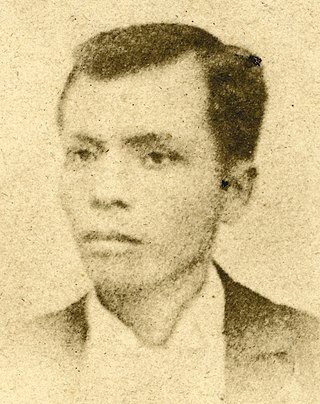Historical revolutionary governments
Philippine Revolution

A revolutionary government was initially established by the Katipunan with the outbreak of the Philippine Revolution in 1896, as the Katipunan's Supreme President Andres Bonifacio reformed its Supreme Council into a "cabinet" still with himself as president. [1] [2] [3] [4] (Prior to this, the Katipunan had itself been established in 1892 with the intention of becoming a shadow government. [5] [6] )
The Tejeros Convention of 1897 was held to reconcile the arguments of two factions of the Katipunan in the province of Cavite, Magdalo and Magdiwang, and it was decided that the Katipunan had to be dissolved to have an election of officers for a revolutionary government. This led to the leadership of the revolution passing to Emilio Aguinaldo, who led a succession of insurgent governments as president and briefly Dictator.
The government established at Tejeros on March 22 (but finalized and first asserted itself on April 24) was succeeded in November by the "Republic of the Philippines", which is today known as the Republic of Biak-na-Bato. That government was disestablished on December 15 by the Pact of Biak-na-Bato and Aguinaldo went into exile, establishing the Hong Kong Junta. In Aguinaldo's absence, the Central Executive Committee was temporarily established as an insurgent revolutionary government. [7] Aguinaldo returned to the Philippines on May 19, 1898, during the Spanish–American War.
The independence of the Philippines from Spain was declared on June 12, and Aguinaldo established himself as dictator in a dictatorial government on June 18. This government was succeeded by a revolutionary government on June 23, with Aguinaldo as president. [8] This was succeeded on January 21, 1899, by the First Philippine Republic, which included an elected legislative branch and a constitution. [9]
Republic of Negros
The Republic of Negros (Hiligaynon : Republika sang Negros; Cebuano : Republika sa Negros; Spanish : República de Negros) was initially established on November 27, 1898, during the Spanish–American War, as a short-lived cantonal revolutionary republic seated in Bacolod, Negros island. On November 5, 1898, Spanish officials surrendered themselves to local Visayan leaders and a provisional government was established. The Federal Republic of Negros was established on January 1, 1899, and a notice of this was sent to Emilio Aguinaldo in Luzon. [10] Negros Island came under U.S. protection on April 30, 1899, as a separate state from the rest of the Philippine Islands. [11] [12] A constitution which proposed two governors, a U.S. military governor and a civil governor elected by the voters of Negros, was framed by a committee sitting in Bacolod and sent to General Otis in Manila and was proclaimed to take effect on July 22, 1899. Elections were held on October 2, reconstituting the republic. It operated smoothly until the province of Occidental Negros was established on April 20, 1901, [13] and annexed to the Philippine Islands by the United States as the Republic of Negros. [14]
Tagalog Republic
Tagalog Republic (Filipino : Republika ng Katagalugan) is a term used to refer to two revolutionary governments involved in the Philippine Revolution against Spain and the Philippine–American War, one in 1896–1897 by Andrés Bonifacio and the other in 1902–1906 by Macario Sakay, who viewed it as a continuation of the former. Both were connected to the Katipunan revolutionary movement.
Republic of Zamboanga
The Republic of Zamboanga was a short-lived sovereign republic, founded on February 28, 1899, by General Vicente Alvarez with his Zamboangueño Revolutionary Forces after the Spanish government in Zamboanga officially surrendered and turned over Fort Pilar to Gen. Vicente Álvarez in May 1899. Gen. Vicente Álvarez proclaimed independence and became the first and last genuinely elected president of the republic. [15] Alverez's cohort, Datu Mandi, flew the white flag over Fort Pilar on November 16, 1899, to signal American forces occupying the Philippines to enter the fort which led to the overthrow of Álvarez's government. Thereafter, the nascent republic became a U.S. protectorate or puppet government and Midel as puppet leader of U.S. was allowed to continue as president of the republic for about sixteen months.
Bangsamoro Republik
The Bangsamoro Republik, officially the United Federated States of Bangsamoro Republik, [16] was a short-lived, self-proclaimed, unrecognized breakaway state in the Philippines. Nur Misuari, chairman of the Moro National Liberation Front, issued the Proclamation of Bangsamoro Independence on July 27, 2013, in Talipao, Sulu, and declared the capital of Bangsamoro to be Davao City. [17]
Aquino administration

Following the fall of the authoritarian administration of President Ferdinand Marcos, the Philippines was praised worldwide in 1986, when the so-called bloodless revolution erupted, called the EDSA People Power Revolution. [18] Due to the People Power Revolution of February 1986, Marcos' successor, President Corazon Aquino, established a revolutionary government with the signing of the "Freedom Constitution" by the virtue of Proclamation No. 3, which established human rights as the core of Philippine democracy. [8]











